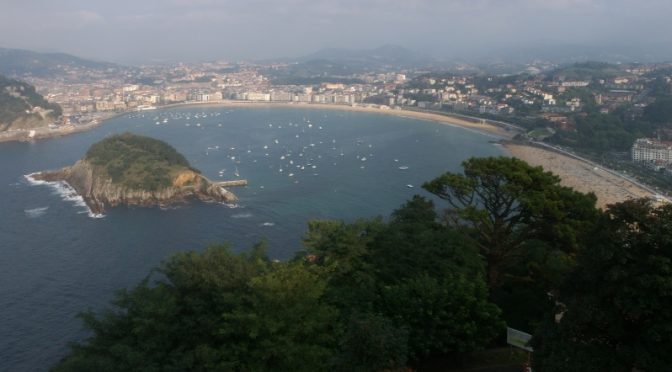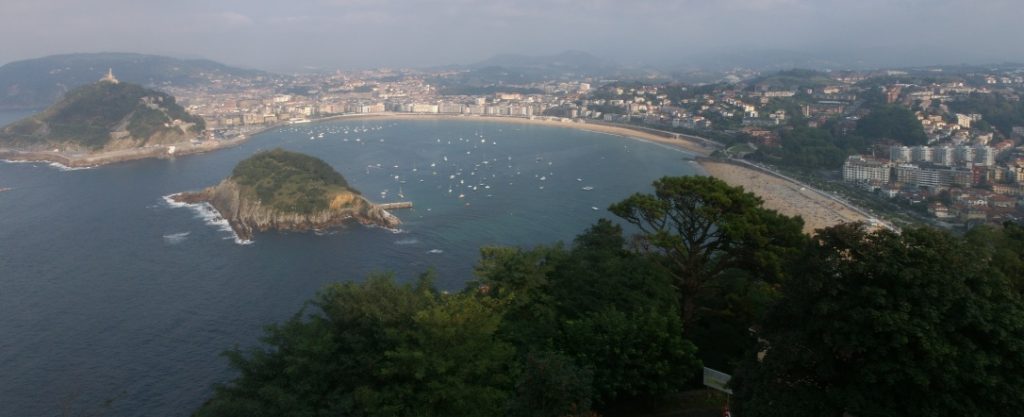My first stay in the Basque County began in the city of Donostia. I really didn’t know anything about the city and I ended up staying in a flat in the Egia neighborhood. I would walk, weather and time permitting, through the tunnel that connected Egia with the downtown, and along La Concha to classes at the University of the Basque Country. More than a few evenings were spent in the Parte Vieja, wandering the streets and bars to the wee hours of the night. Looking back, it was a special time in a special city. I don’t think I realized how lucky I was to live in such a majestic place.
- Donostia straddles the mouth of the Urumea river. Mount Urgull sits at the mouth, rising on the western bank. To the west, just past the beaches of La Concha and Ondarreta, rises Mount Igeldo. In the middle of the bay Bahía de la Concha sits the island of Santa Clara.
- In 1863, the walls, built over many years to make Donostia a military stronghold, were demolished. This opened up the surrounding region for development and the city exploded. Donostia has over 25 different barrios or neighborhoods. At the heart is the Parte Vieja or Parte Zaharra, the center that was surrounded by those original walls.
- The coat-of-arms of the city consists of a ship with its sails spread over the waves of the sea and a banner that reads “For fidelity, nobility and loyalty earned.”
- The city currently has about 187,000 residents. The primary economic engine of the city is service and tourism. Two of the biggest events hosted by the city are the San Sebastian Jazz Festival (Jazzaldia) and the San Sebastián International Film Festival. The city also hosts several fiestas, including La Tamborrada, La Semana Grande/Aste Nagusia, Basque Week/Euskal Jaiak, and San Juan Sua.
- Donostia is perhaps most famous for its food. It has a high concentration of Michelin Stars – it has the second highest density of Stars, second only to Kyoto, Japan. It boasts many world-class restaurants, including Arzak, Berasategui, Akelarre, and Mugaritz, currently ranked #21 in the world. Of course, the entire city but particularly the Parte Vieja is famous for its pintxos. And there are the txokos, or gastronomic societies, sanctuaries of food.
- The other big attraction is the city’s soccer (sorry, futbol!) team, Real Sociedad. Founded in 1909, it has won La Liga twice, in the 1980-81 and 1981-82 campaigns. It once had a policy of fielding only Basque players, like Athletic Bilbao, but changed that policy in 1989. Real is currently sitting at third place in La Liga, behind Barcelona and Real Madrid. A women’s team was founded in 2004.
- Of course, there are many landmarks in the city. The Peine del Viento – the Comb of the Wind – by Eduardo Chillida is one of the primary artistic attractions. Both Mount Igeldo and Mount Urgull offer majestic views of the city. The San Telmo Museum provides an excellent introduction to Basque history and culture. Other sites include Tabakalera, a former tobacco factory that is now a cultural center; the Buen Pastor Cathedral, the Santa María del Coro Basilica, and the San Vicente Church; the City Hall; the Plaza de la Constitución; and Miramar Palace.
Primary sources: Barrena Osoro, Elena [et al.]. Donostia / San Sebastián. Historia. Auñamendi Encyclopedia. Available at: https://aunamendi.eusko-ikaskuntza.eus/en/donostia-san-sebastian-historia/ar-45908/; Auñamendi Entziklopedia. Donostia / San Sebastián. Auñamendi Encyclopedia . Available at: https://aunamendi.eusko-ikaskuntza.eus/en/donostia-san-sebastian/ar-36359/; San Sebastián, Wikipedia
Discover more from Buber's Basque Page
Subscribe to get the latest posts sent to your email.




4 thoughts on “Basque Fact of the Week: Donostia, the Capital of Gipuzkoa, Part 1: The City”